French Bean Production as Influenced by Biochar and Biochar Blended Manure Application in Two Agro-Ecological Zones of Rwanda
Abstract
:1. Background
2. Material and Methods
2.1. Description of the Study Site and Experiments
2.2. Biochar and Manure Preparation
2.3. Soil, Biochar, and Livestock Manure Analysis
2.4. Determination of French Bean Yield
2.5. Statistical Analysis
3. Results
3.1. The Effect of Co-Applying Biochar with Manure on French Bean Yield
3.2. The Effect of Biochar and Biochar + Manure on Soil Chemical Properties
4. Discussion
Biochar and Biochar + Manure Effect on Yield of French Beans in the Studied Soils
5. Conclusions
Supplementary Materials
Author Contributions
Funding
Data Availability Statement
Acknowledgments
Conflicts of Interest
References
- Uwiragiye, Y.; Ngaba, M.J.Y.; Zhao, M.; Elrys, A.S.; Heuvelink, G.B.; Zhou, J. Modelling and mapping soil nutrient depletion in humid highlands of East Africa using ensemble machine learning: A case study from Rwanda. Catena 2022, 217, 106499. [Google Scholar] [CrossRef]
- Vanlauwe, B.; Descheemaeker, K.; Giller, K.E.; Huising, J.; Merckx, R.; Nziguheba, G.; Wendt, J.; Zingore, S. Integrated soil fertility management in sub-Saharan Africa: Unravelling local adaptation. SOIL 2015, 1, 491–508. [Google Scholar] [CrossRef]
- Stewart, Z.P.; Pierzynski, G.M.; Middendorf, B.J.; Prasad, P.V.V. Approaches to improve soil fertility in sub-Saharan Africa. J. Exp. Bot. 2020, 71, 632–641. [Google Scholar] [CrossRef] [PubMed]
- Nduwumuremyi, A.; Habimana, S.; Twizerimana, A.; Mupenzi, J. Soil acidity analysis and estimation of lime requirement for rectifying soil acidity. Int. Invent. J. Agric. 2017, 2, 22–26. [Google Scholar]
- Mukurarinda, A.; Ndayambaje, J.D.; Iiyama, M.; Ndoli, A.; Musana, B.S.; Garrity, D.; Ling, S. Taking to Scale Tree-Based Systems in Rwanda to Enhance Food Security, Restore Degraded Land, Improve Resilience to Climate Change and Sequester Carbon; PROFOR, ICRAF: Washington, DC, USA, 2016; 46p. [Google Scholar]
- Sangsuk, S.; Buathong, C.; Suebsiri, S. High-energy conversion efficiency of drum kiln with heat distribution pipe for charcoal and biochar production. Energy Sustain. Dev. 2020, 59, 1–7. [Google Scholar] [CrossRef]
- Ndambi, O.A.; Pelster, D.E.; Owino, J.O.; de Buisonjé, F.; Vellinga, T. Manure Management Practices and Policies in Sub-Saharan Africa: Implications on Manure Quality as a Fertilizer. Front. Sustain. Food Syst. 2019, 3, 29. [Google Scholar] [CrossRef]
- Ministry of Agriculture and Animal Resource (Minagri). Annual Report FY 2015-2016. p. 123. Kigali, Rwanda. Available online: https://innspub.net/the-effect-of-biochar-and-cowmanure-to-increase-soil-fertility-in-entisol-darussalam/ (accessed on 15 July 2022).
- Nguyen, B.T.; Trinh, N.; Le, C.M.T.; Nguyen, T.T.; Tran, T.V.; Thai, B.V.; Le, T.V. The interactive effects of biochar and cow manure on rice growth and selected properties of salt-affected soils. Arch. Agron. Soil Sci. 2018, 64, 1744–1758. [Google Scholar] [CrossRef]
- Razzaghi, F.; Obour, P.B.; Arthur, E. Does biochar improve soil water retention? A systematic review and meta-analysis. Geoderma 2019, 361, 114055. [Google Scholar] [CrossRef]
- Partey, S.T.; Preziosi, R.F.; Robson, G.D. Short-Term Interactive Effects of Biochar, Green Manure, and Inorganic Fertilizer on Soil Properties and Agronomic Characteristics of Maize. Agric. Res. 2014, 3, 128–136. [Google Scholar] [CrossRef]
- Adekiya, A.O.; Agbede, T.M.; Ejue, W.S.; Aboyeji, C.M.; Dunsin, O.; Aremu, C.O.; Owolabi, A.O.; Ajiboye, B.O.; Okunlola, O.F.; Adesola, O.O. Biochar, poultry manure and NPK fertilizer: Sole and combine application effects on soil properties and ginger (Zingiber officinale Roscoe) performance in a tropical Alfisol. Open Agric. 2020, 5, 30–39. [Google Scholar] [CrossRef]
- Wisnubroto, E.I.; Tunggadewi, M.U.T.; Utomo, W.H.; Indrayatie, E.R. Residual Effect of Biochar on Growth and Yield of Red Chili (Capsicum annum L.). J. Adv. Agric. Technol. 2017, 4, 28–32. [Google Scholar] [CrossRef]
- Adekiya, A.O.; Agbede, T.M.; Aboyeji, C.M.; Dunsin, O.; Simeon, V.T. Effects of biochar and poultry manure on soil characteristics and the yield of radish. Sci. Hortic. 2019, 243, 457–463. [Google Scholar] [CrossRef]
- Habieb, M.; Zaitun, S. The effect of biochar and cow manure to increase soil fertility in Entisol Darussalam. Int. J. Agron. Agrc. Res. 2018, 13, 1–7. [Google Scholar]
- Dai, Z.; Zhang, X.; Tang, C.; Muhammad, N.; Wu, J.; Brookes, P.C.; Xu, J. Potential role of biochars in decreasing soil acidification—A critical review. Sci. Total Environ. 2017, 581–582, 601–611. [Google Scholar] [CrossRef] [PubMed]
- de la Rosa, J.M.; Rosado, M.; Paneque, M.; Miller, A.Z.; Knicker, H. Effects of aging under field conditions on biochar structure and composition: Implications for biochar stability in soils. Sci. Total Environ. 2018, 613–614, 969–976. [Google Scholar] [CrossRef]
- Li, G.; Nazir, M.M.; Zulfiqar, F.; Siddique, K.H.; Iqbal, B.; Du, D. Harnessing soil carbon sequestration to address climate change challenges in agriculture. Soil Tillage Res. 2024, 237, 105959. [Google Scholar] [CrossRef]
- Shifa, S.; Worku, M.; Beyene, A. Co-application of compost and biochar improves soil properties and Desho grass growth on acidic soils in a tropical environment of Southwestern Ethiopia. Cogent Food Agric. 2023, 10, 2290338. [Google Scholar] [CrossRef]
- Dong, X.; Li, G.; Lin, Q.; Zhao, X. Quantity and quality changes of biochar aged for 5 years in soil under field conditions. Catena 2017, 159, 136–143. [Google Scholar] [CrossRef]
- Solaiman, Z.M.; Shafi, M.I.; Beamont, E.; Anawar, H.M. Poultry Litter Biochar Increases Mycorrhizal Colonisation, Soil Fertility and Cucumber Yield in a Fertigation System on Sandy Soil. Agriculture 2020, 10, 480. [Google Scholar] [CrossRef]
- Antonangelo, J.A.; Culman, S.; Zhang, H. Comparative analysis and prediction of cation exchange capacity via summation: Influence of biochar type and nutrient ratios. Front. Soil Sci. 2024, 4, 1371777. [Google Scholar] [CrossRef]
- I.U.S.S. Working Group. World Reference Base for Soil Resources 2014 Update 2016. International Soil Classification System for Naming Soils and Creating Legends for Soil Maps; World Soil Resources Reports (2016); No. 106; FAO: Rome, Italy, 2016. [Google Scholar]
- Akinrinde, E.A.; Obigbesan, G.O. Evaluation of fertility status of selected soil for crop production in five ecological areas of Nigeria. In Proceedings of the 26th Annual Conference of Soil Science Society of Nigeria, Ibadan, Nigeria, 6–10 December 2000; pp. 279–288. [Google Scholar]
- Wogi, L.; Dechassa, N.; Haileselassie, B.; Mekuria, F.; Abebe, A.; Tamene, L.D. A Guide to Standardized Methods of Analysis for Soil, Water, Plant, and Fertilizer Resources for Data Documentation and Sharing in Ethiopia; International Center for Tropical Agriculture. Publication: Addis Ababa, Ethiopia, 2021; p. 41. [Google Scholar]
- Glaser, B.; Lehr, V.-I. Biochar effects on phosphorus availability in agricultural soils: A meta-analysis. Sci. Rep. 2019, 9, 9338. [Google Scholar] [CrossRef]
- Okalebo, J.R.; Gathua, K.W.; Woomer, P.L. Laboratory Methods of Soil and Plant Analysis: Working Manual, 2nd ed.; Springer: Berlin/Heidelberg, Germany, 2002; p. 128. [Google Scholar]
- Bremmer, J.M.; Mulvaney, C.S. Total nitrogen. In Methods of Soil Analysis, Part 2, 2nd ed.; Page, L.A., Miller, R.H., Keeney, D.R., Eds.; American Society Agronomy: Madison, WI, USA, 1982; pp. 595–624. [Google Scholar]
- Nelson, D.W.; Sommers, L.E. Total organic carbon. In Methods of Soil Analysis, Part 2. Chemical and Microbiological Properties; Page, A.L., Ed.; American Society of Agronomy: Madison, WI, USA, 1982; Volume 2, pp. 539–579. [Google Scholar]
- Thomas, G.W. Exchangeable cations. In Methods of Soil Analysis, 2nd ed.; Page, L.A., Miller, R.H., Keeney, D.R., Eds.; American Society Agronomy & Soil Science Society of America: Madison, WI, USA, 1982; pp. 595–624. [Google Scholar]
- D3174-12; Ash in the Analysis Sample of Coal and Coke from Coal. Standards ASTM International: West Conshohocken, PA, USA, 2018.
- Bates, D.; Mächler, M.; Bolker, B.; Walker, S. Fitting Linear Mixed-Effects Models Using lme4. J. Stat. Softw. 2015, 67, 48. [Google Scholar] [CrossRef]
- Oni, B.A.; Oziegbe, O.; Olawole, O.O. Significance of biochar application to the environment and economy. Ann. Agric. Sci. 2019, 64, 222–236. [Google Scholar] [CrossRef]
- Huang, Y.; Tao, B.; Lal, R.; Lorenz, K.; Jacinthe, P.-A.; Shrestha, R.K.; Bai, X.; Singh, M.P.; Lindsey, L.E.; Ren, W. A global synthesis of biochar’s sustainability in climate-smart agriculture—Evidence from field and laboratory experiments. Renew. Sustain. Energy Rev. 2023, 172, 113042. [Google Scholar] [CrossRef]
- Gudade, B.; Malik, G.C.; Das, A.; Bhupenchandra, I.; Malik, C.; Das, A.; Babu, S.; Kumar, A. Effect of biochar levels and inte-grated nutrient-management practices on agro-physiological performance and productivity of maize (Zea mays). Indian J. Agron. 2022, 67, 380–385. [Google Scholar] [CrossRef]
- Khan, Z.; Xu Jian, Y.; Fu, Y.; Joseph, S.; Khan, M.N.; Alam, I.; Shen, H. Engineered Biochar improves nitrogen use efficiency via stabilizing soil water-stable macro aggregates and enhancing nitrogen transformation. Biochar 2023, 5, 2–37. [Google Scholar] [CrossRef]
- Olmo, M.; Villar, R.; Salazar, P.; Alburquerque, J.A. Changes in soil nutrient availability explain biochar’s impact on wheat root development. Plant Soil 2015, 399, 333–343. [Google Scholar] [CrossRef]
- Ayito, E.O.; John, K.; Benjamin, O.I.; John, N.M.; Mngadi, S.; Heung, B.; Abbey, L.; Agyeman, P.C.; Moodley, R. Synergistic effects of biochar and poultry manure on soil and cucumber (Cucumis sativus) performance: A case study from the southeastern Nigeria. Soil Sci. Annu. 2023, 74, 183903. [Google Scholar] [CrossRef]
- Liu, M.; Linna, C.; Ma, S.; Ma, Q.; Song, W.; Shen, M.; Song, L.; Cui, K.; Zhou, Y.; Wang, L. Biochar combined with organic and inorganic fertilizers promoted the rapeseed nutrient uptake and improved the purple soil quality. Front. Nutr. 2022, 9, 997151. [Google Scholar] [CrossRef]
- Agbede, T.M.; Adekiya, A.O.; Eifediyi, E.K. Impact of Poultry Manure and NPK Fertilizer on Soil Physical Properties and Growth and Yield of Carrot. J. Hortic. Res. 2017, 25, 81–88. [Google Scholar] [CrossRef]
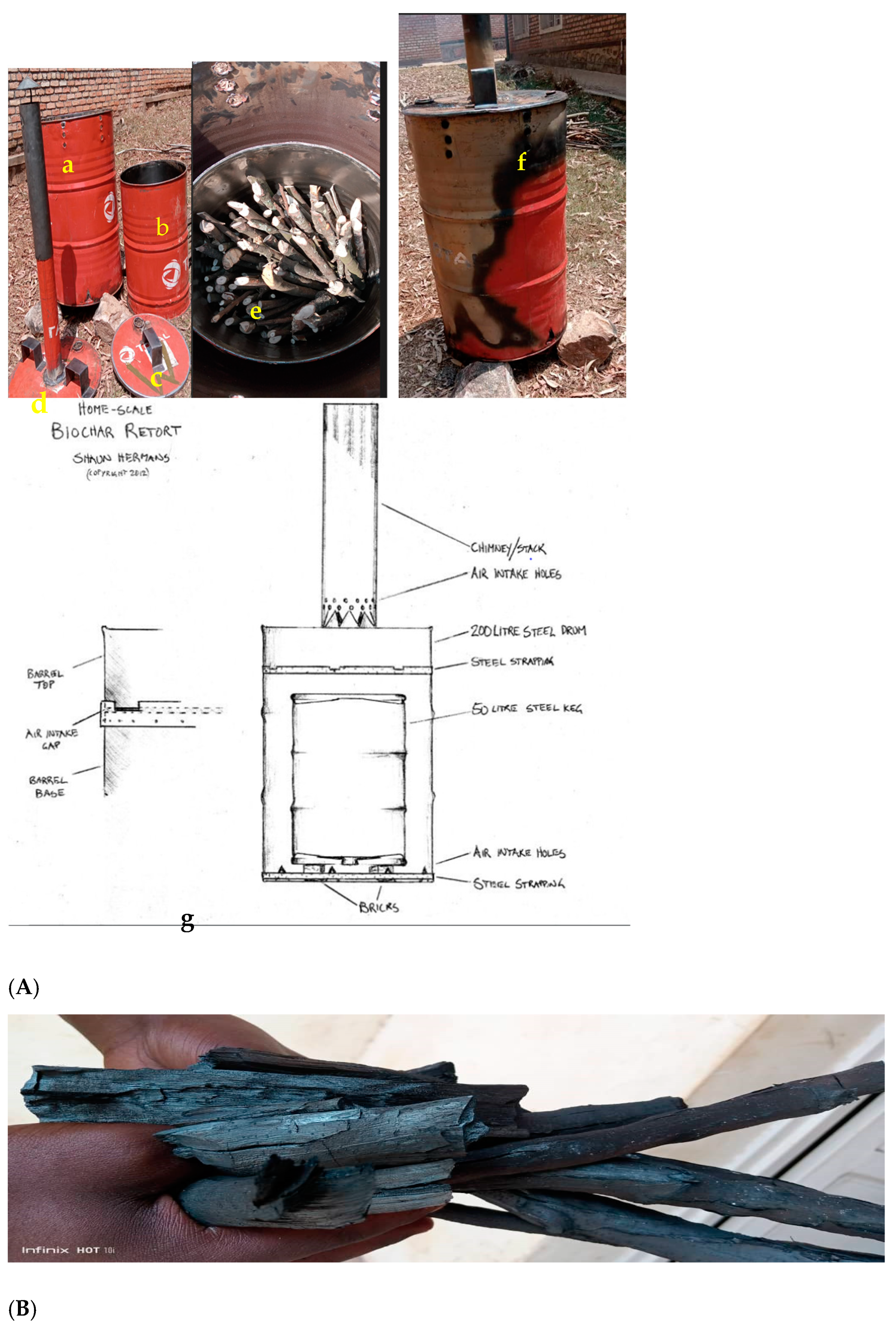

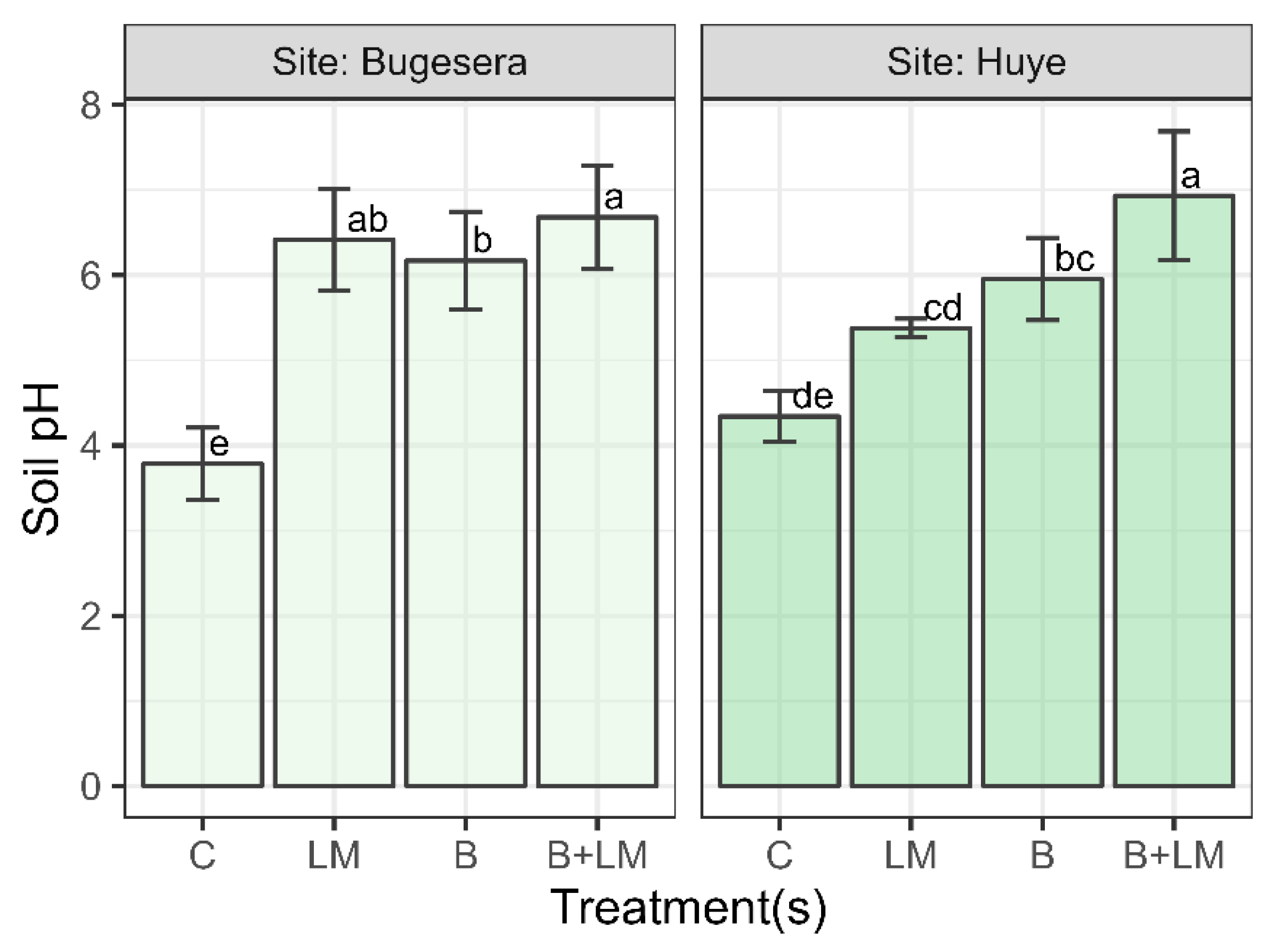
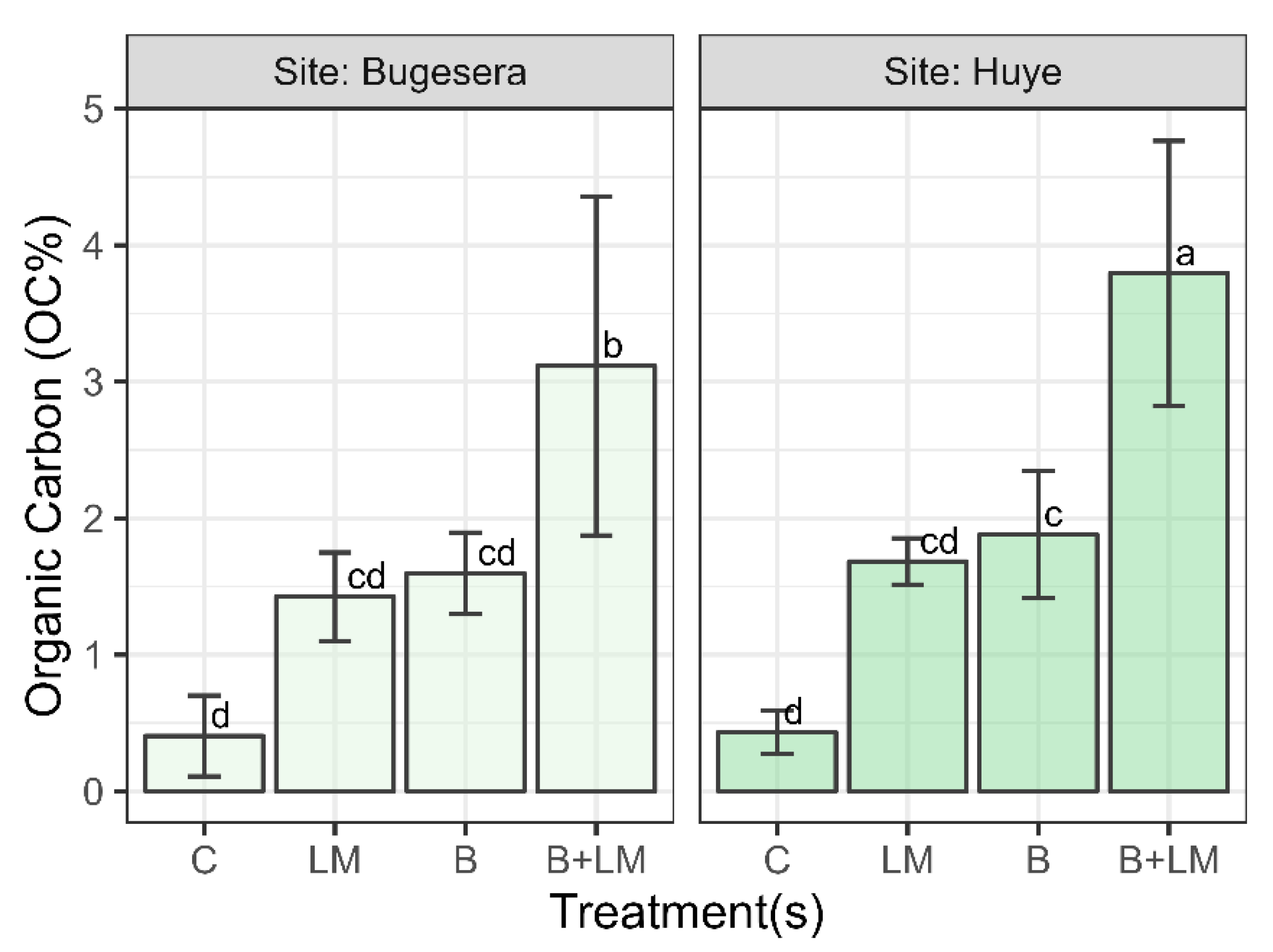
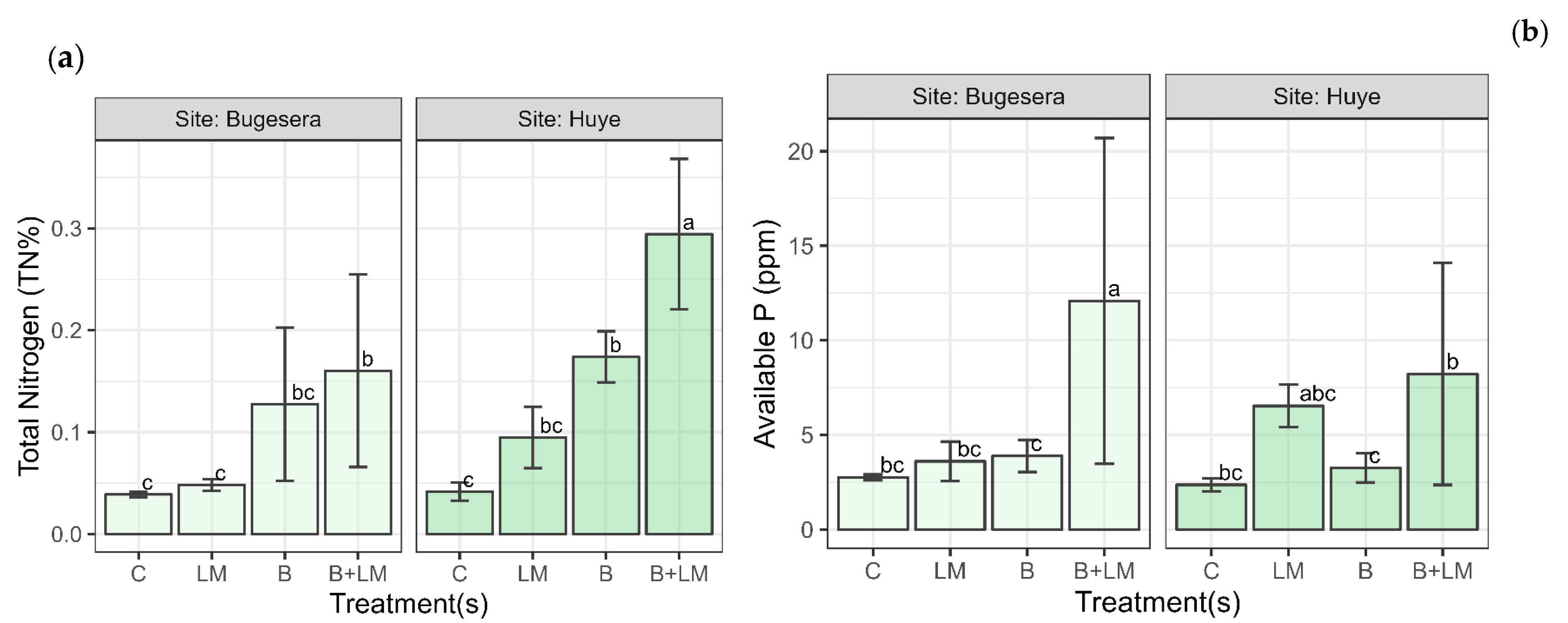
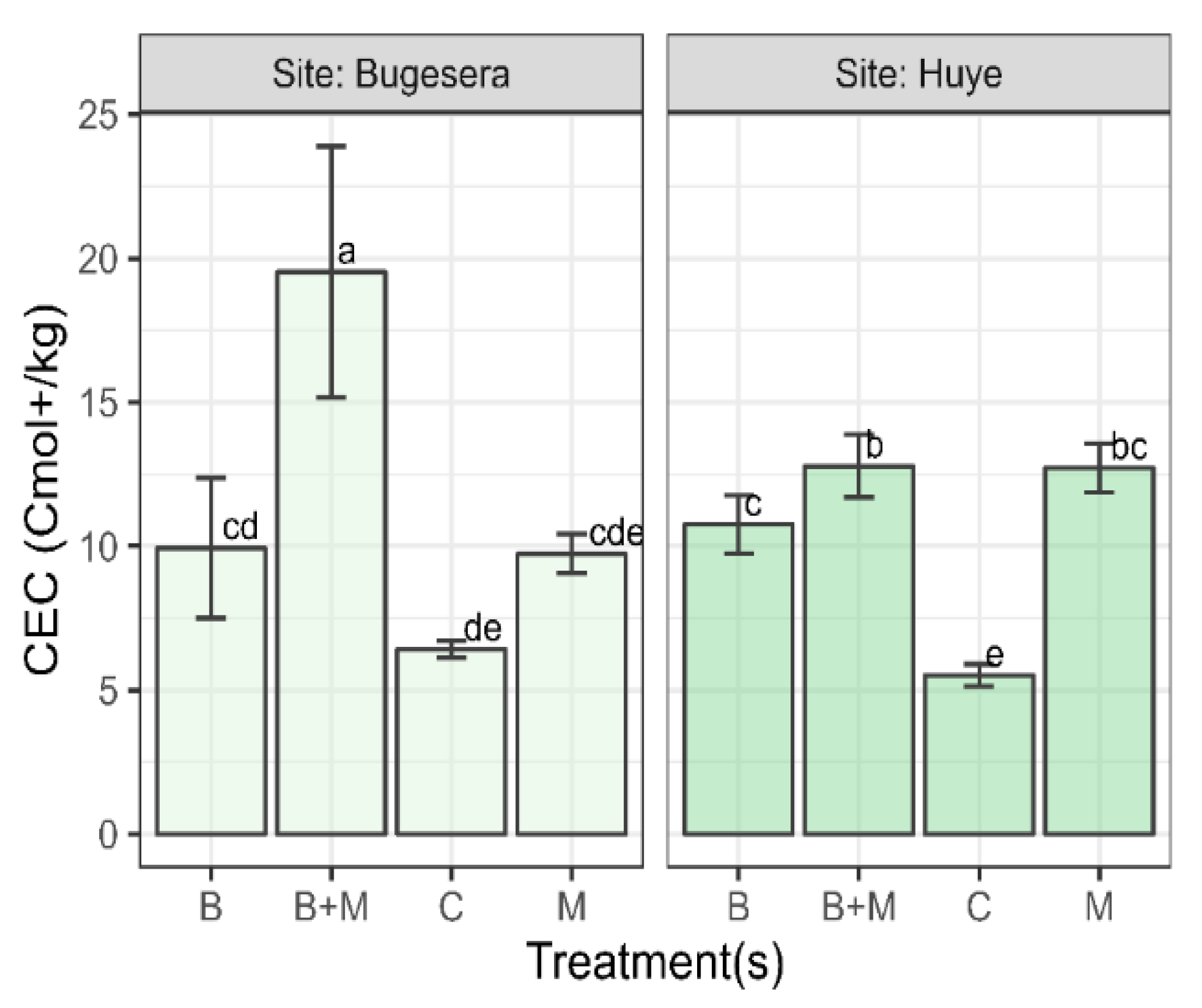
| Tonga Station | Rusagara Station | |
|---|---|---|
| Latitude | 1°33′37″ S | 2°12′19″ S |
| Longitude | 30°05′28″ E | 30°13′04″ E |
| Temperature (°C) | 20 | 27 |
| Annual rainfall (mm) | 1160 | 943 |
| Soil classification | Gleyic Acrisols | Ferralic Cambisols |
| Land use/vegetation | Follow | Agriculture/maize |
| Texture | Sand clay loam | Sandy loam |
| Soil pH | 4.34 ± 0.4 | 4.01 ± 0.75 |
| Soil Organic Carbon (S.OC) % | 0.74 ± 0.39 | 0.68 ± 0.47 |
| Cation Exchange Capacity (CEC) (col(+)/kg) | 4.63 ± 1.43 | 3.84 ± 1.07 |
| Available Phosphorus (P) | 3.08 ± 1.15 | 3.71 ± 1.04 |
| Total Nitrogen (T.N.) % | 0.06 ± 0.02 | 0.04 ± 0.02 |
| Soil Parameters | BE | BGr | BGl | Bses | BAc | LM |
|---|---|---|---|---|---|---|
| pH | 9.33 | 9.05 | 9.87 | 7.96 | 7.26 | 9.00 |
| EC ds/m | 1.35 | 2.42 | 2.86 | 3.45 | 3.79 | 2.51 |
| Total OC (%) | 71.80 | 79.7 | 65.00 | 70.89 | 68.00 | 50.82 |
| TN (%) | 0.68 | 0.38 | 1.00 | 1.52 | 1.32 | 2.40 |
| Total P (%) | 0.09 | 0.03 | 0.04 | 0.07 | 0.04 | 0.90 |
| CEC(cmol+/kg) | 26.40 | 24.00 | 28.1 | 45.7 | 45.8 | 67.25 |
| Total Ca (ppm) | 0.12 | 0.27 | 0.44 | 0.42 | 0.39 | 0.35 |
| Total K (ppm) | 0.15 | 1.36 | 4.35 | 4.67 | 5.78 | 2.82 |
| Total Mg (ppm) | 0.19 | 0.17 | 0.12 | 0.15 | 0.19 | 0.21 |
| Ashes (%) | 0.78 | 0.65 | 2.10 | 0.60 | 0.20 | - |
| Trt Code | Biochar Application (t/ha) | Manure Application (t/ha) | N |
|---|---|---|---|
| B0 + MO (Control) | 0 | 0 | 4 |
| B1E | 1 | 0 | 4 |
| B1Gl | 1 | 0 | 4 |
| B1Ses | 1 | 0 | 4 |
| B1Gr | 1 | 0 | 4 |
| B3E | 3 | 0 | 4 |
| B3Ses | 3 | 0 | 4 |
| B3Ac | 3 | 0 | 4 |
| LM1 | 0 | 1 | 4 |
| LM3 | 0 | 3 | 4 |
| B1E + LM1 | 1 | 1 | 4 |
| B1Ses + LM1 | 1 | 1 | 4 |
| B1E + LM3 | 1 | 3 | 4 |
| B1Ses + LM3 | 1 | 3 | 4 |
| B3E + LM1 | 3 | 1 | 4 |
| B3Ses + LM1 | 3 | 1 | 4 |
| B3E + LM3 | 3 | 3 | 4 |
| B3Ses + LM3 | 3 | 3 | 4 |
Disclaimer/Publisher’s Note: The statements, opinions and data contained in all publications are solely those of the individual author(s) and contributor(s) and not of MDPI and/or the editor(s). MDPI and/or the editor(s) disclaim responsibility for any injury to people or property resulting from any ideas, methods, instructions or products referred to in the content. |
© 2024 by the authors. Licensee MDPI, Basel, Switzerland. This article is an open access article distributed under the terms and conditions of the Creative Commons Attribution (CC BY) license (https://creativecommons.org/licenses/by/4.0/).
Share and Cite
Uwingabire, S.; Chamshama, S.A.O.; Nduwamungu, J.; Nyberg, G. French Bean Production as Influenced by Biochar and Biochar Blended Manure Application in Two Agro-Ecological Zones of Rwanda. Agronomy 2024, 14, 2020. https://doi.org/10.3390/agronomy14092020
Uwingabire S, Chamshama SAO, Nduwamungu J, Nyberg G. French Bean Production as Influenced by Biochar and Biochar Blended Manure Application in Two Agro-Ecological Zones of Rwanda. Agronomy. 2024; 14(9):2020. https://doi.org/10.3390/agronomy14092020
Chicago/Turabian StyleUwingabire, Solange, Shaban Athuman Omar Chamshama, Jean Nduwamungu, and Gert Nyberg. 2024. "French Bean Production as Influenced by Biochar and Biochar Blended Manure Application in Two Agro-Ecological Zones of Rwanda" Agronomy 14, no. 9: 2020. https://doi.org/10.3390/agronomy14092020





